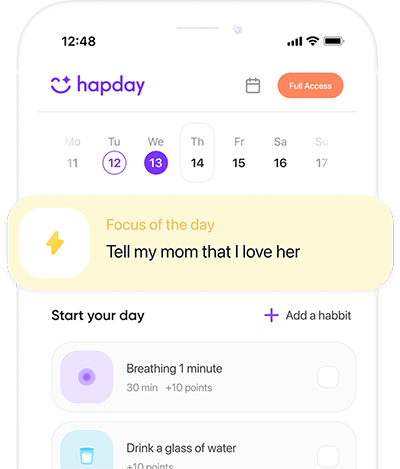Table of Contents
- What Is Mindfulness?
- The Science of Mindfulness
- How Mindfulness Elevates Mood
- Practical Mindfulness Techniques for a Happier Mood
- 1. Mindful Breathing
- 2. Body Scan Meditation
- 3. Mindful Walking
- 4. Loving-Kindness Meditation
- 5. Gratitude Journaling
- 6. Mindful Eating
- 7. Mindful Journaling
- Incorporating Mindfulness into Everyday Life
- Conclusion
What Is Mindfulness?
Mindfulness is essentially about living in the present—embracing every moment fully and without judgment. It’s about truly experiencing life as it unfolds, rather than getting bogged down by past regrets or future anxieties. This practice, deeply rooted in Buddhist traditions, has become a modern ally in mental wellness. A study published in Psychological Science reveals how mindfulness can significantly reduce stress and anxiety, thereby enhancing one’s mood and overall well-being.
The Science of Mindfulness
Mindfulness isn’t just a feel-good concept; it’s backed by compelling science. Studies, like one from Harvard University, show that after only eight weeks of mindfulness meditation, there are tangible changes in brain areas associated with attention and emotion regulation. Imagine that! These changes can help you gain better control over your thoughts and emotions, crucial elements of a happy and positive life.
Moreover, mindfulness practices impact the amygdala, the brain’s emotional processor. According to research in Social Cognitive and Affective Neuroscience, mindfulness can ease amygdala activity, helping to soften our automatic stress responses, and encouraging a calmer approach to life’s obstacles.
How Mindfulness Elevates Mood
Stress Reduction
Stress is a notorious barrier to happiness, clouding our mood and health. Mindfulness offers a remedy, as supported by a meta-analysis in JAMA Internal Medicine. The study demonstrates that mindfulness practices can significantly ease anxiety, depression, and even physical pain. By dialing down stress, mindfulness creates fertile ground for joy to flourish.
Emotional Regulation
The ability to steer your emotions constructively is key to maintaining happiness. Mindfulness sharpens this ability, enhancing awareness and enabling measured responses instead of knee-jerk reactions. Research in Frontiers in Psychology highlights mindfulness’s role in boosting emotional resilience, leading to a more stable, happier disposition.
Increased Self-Awareness
Self-awareness breeds happiness. When you understand your inner workings, you live more intentionally, crafting choices that resonate with your true self. Mindfulness encourages this clarity by allowing you to observe your inner life without criticism. This improved self-understanding can lead to greater satisfaction, as reflected in studies published in Emotion.
Better Cognitive Function
Mindfulness doesn’t just stop at emotional benefits; it also buffs up your mental skills. A study in Psychological Science links mindfulness to improved memory and decision-making abilities, which, in turn, can enhance your self-confidence and satisfaction.
Practical Mindfulness Techniques for a Happier Mood
1. Mindful Breathing
A simple yet powerful technique, mindful breathing focuses your attention on each breath, grounding you in the present and soothing your mind.
Try This:
- Find a peaceful spot to sit comfortably.
- Close your eyes and take a few deep breaths in through your nose and out through your mouth.
- Notice the natural rhythm of your breathing, and if your mind starts to wander, gently bring your focus back to your breath.
2. Body Scan Meditation
This meditation guides you through each part of your body, fostering relaxation and body awareness.
Try This:
- Lie comfortably on your back.
- Close your eyes and take deep breaths.
- Focus first on your toes, then gradually move your attention upward through each part of your body.
- As you notice tension, breathe into it, letting it slowly release.
3. Mindful Walking
Mindful walking blends movement with mindfulness, anchoring you in the moment through each step.
Try This:
- Choose a tranquil walking path.
- Stand still, close your eyes briefly, and breathe deeply.
- Walk slowly, tuning into the sensation of your feet touching the earth and the motion of your body.
- Stay present, redirecting your wandering mind back to the walk.
4. Loving-Kindness Meditation
This practice nurtures positive emotions towards yourself and others, expanding your capacity for compassion.
Try This:
- Sit comfortably and close your eyes.
- Repeat phrases like, “May I be happy, may I be healthy,” then extend this goodwill to loved ones and wider circles.
5. Gratitude Journaling
Gratitude journaling shifts your focus from scarcity to abundance, enriching your sense of joy.
Try This:
- Every day, jot down three things you’re grateful for.
- Reflect on why these bring joy and how they enhance your life.
6. Mindful Eating
This practice involves fully attending to the eating experience, transforming meals into a moment of gratitude and enjoyment.
Try This:
- Savor each bite, placing your fork down between bites.
- Notice flavors, textures, and aromas, and tune into your body’s hunger signals.
7. Mindful Journaling
Mindful journaling allows you to explore your thoughts and feelings freely, providing insights and stress relief.
Try This:
- Regularly write about your experiences, focusing on thoughts and emotions without judgment.
- Revisit your entries to identify patterns and positive shifts.
Incorporating Mindfulness into Everyday Life
Making mindfulness a part of your daily routine doesn’t have to be daunting. Start small, and build gradually:
- Begin Briefly: Start with short mindfulness practices, extending them over time.
- Be Regular: Schedule a daily practice, whether morning, noon, or night.
- Foster Patience: Remember, mindfulness is a journey with ups and downs.
- Stay Open: Embrace each session’s learning, even if it’s challenging.
- Connect: Joining a mindfulness group or therapy can offer support and enrich your journey.


‘Better cognitive function’ sounds great, but I’m skeptical about how much mindfulness can really help with that. Can anyone share real-life examples of improved decision-making from practicing mindfulness? I’m curious!
‘Mindfulness has helped me avoid rash decisions at work by giving me time to think before reacting.’
‘Real-life examples’ are hard to come by, but I’ve noticed clearer thinking during stressful times since I started meditating!
‘Mindful Walking’ sounds interesting; however, I’m unsure how walking slowly will help me clear my mind when I’ve got a million things racing through it. Perhaps there’s a quick version for those of us who prefer speed over tranquility?
[…] It’s essential that we integrate mindfulness into our busy lives without dismissing its challenges. Even though the article emphasizes starting small, many people struggle with consistency amidst everyday chaos. How do you suggest overcoming these obstacles practically?
‘Mindful Eating’? So basically they’re asking us to be present while we devour our snacks? Great, now I feel guilty about binge-watching shows with chips—guess I’ll have to chew slowly while contemplating my life choices.
…and on that note, I think we should embrace the imperfections in our journey towards mindfulness! Stressing over ‘doing it right’ can defeat the purpose entirely. Let’s take it easy and enjoy each step!
I love how this post emphasizes the importance of being present! Mindfulness is such a game changer. I’ve started practicing mindful breathing, and it really helps me to reduce anxiety. I can’t believe how just focusing on my breath can create such a calm feeling. Anyone else had similar experiences?
Mindful breathing is definitely underrated! It’s amazing how quickly you can shift your mood with just a few deep breaths.
Absolutely! I never thought something so simple could make such a big difference. It’s like hitting the reset button on my mind.
…and while I’m skeptical about some trends, this one seems backed by real science! The emotional regulation part really caught my attention—it’s something I’ve struggled with over the years.
This article is packed with useful information! The section on emotional regulation really resonated with me. It’s incredible to think that mindfulness can actually change how our brains work over time. Does anyone have tips on incorporating these techniques into a busy schedule?
I’ve found that even a few minutes in the morning for mindful breathing can set a positive tone for the day!
…and speaking of mindful walking, imagine doing that in nature! There’s something so calming about being outdoors while practicing mindfulness—it’s like two forms of therapy combined!
This article is such a treasure trove of information! The science behind mindfulness is fascinating, especially how it can actually change our brains. I’m curious about the body scan meditation—does anyone have tips for beginners? I tend to get distracted easily!
I read somewhere that it gets easier with practice! Maybe try listening to a guided meditation? That might help keep your mind focused.
For beginners, it’s helpful to start in a quiet space and focus on your breath. Just be patient with yourself; distractions are totally normal!
‘Gratitude journaling’ sounds lovely! I think it’s so important to focus on the good things in life, especially when times get tough. Has anyone kept a gratitude journal consistently? What was your experience like?
This article is a breath of fresh air! Mindfulness has transformed my life for the better. I never realized how much stress I was carrying until I started practicing mindful breathing and journaling. The scientific backing makes it even more credible. Thank you for sharing such valuable insights!
I feel like mindfulness is getting more attention lately, but it can be hard to fit into our busy lives. I appreciate the practical tips here! Mindful walking sounds particularly interesting and doable.
…but honestly, do we really need yet another thing on our plate? Mindfulness sounds good and all, but sometimes I think it’s just another trend. I wonder how many people actually stick with it long-term?
I absolutely love the idea of incorporating mindfulness into our daily lives! The concept of mindful eating really resonates with me. It’s so easy to rush through meals without appreciating them. I can’t wait to try out some techniques, especially the gratitude journaling! It feels like a great way to cultivate a more positive outlook.
“Gratitude Journaling” sounds like a fancy way of saying ‘write down your complaints and then try to convince yourself they’re blessings.’ Next thing you know, we’ll be journaling about how grateful we are for the Wi-Fi that keeps us distracted!
Honestly, can we stop pretending that mindfulness is the cure-all? Sure, it sounds nice in theory, but in reality, it’s just another buzzword used to sell overpriced retreats and books. Not everyone has time to sit and meditate while the world keeps spinning around them.
While I appreciate the article’s intent, I find the argument that mindfulness is universally beneficial quite flawed. Different people have different needs; some may require therapy or medication instead of meditation techniques. Mindfulness should not replace professional help for serious mental health issues.
It’s fascinating how mindfulness is not only rooted in ancient practices but also supported by modern science. The studies mentioned really highlight its benefits on emotional regulation and cognitive function. It would be interesting to see more research exploring its long-term effects on mental health.
“Loving-Kindness Meditation”? More like ‘Let’s Sit Around and Wish Well For Everyone’! Don’t get me wrong—spreading love is great, but if I’m being honest, sometimes all I want is to channel my inner grouch without having to meditate about it.